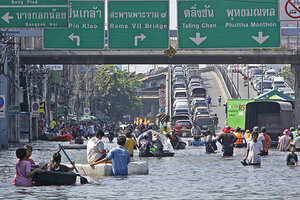Thailand floods: At the floodwaters' edge, entrepreneurs flourish
Floods in Thailand have killed 437 people and submerged the northern suburbs and towns. As floodwaters slowly make their way to the center of Bangkok, locals are showing a can-do ethos.

Residents wade through floodwaters in the Bang Phlat district of Bangkok, Tuesday. Higher than normal tides pushing into the Chao Phraya river from the Gulf of Thailand in recent days have complicated efforts to drain floodwaters flowing from the country's central heartland, where vast areas have been submerged for up to two months.
Sakchai Lalit/AP
Bangkok, Thailand
As floodwaters edge closer to some of Bangkok's hitherto-dry central areas some enterprising people – including those affected by the waters – are doing a steady business selling flood-related provisions.
For more than two weeks, the floods that have killed 437 people and submerged northern suburbs and towns to the north, have been slowly making their way to the center of Bangkok. The west bank of the Chao Phraya River, the central part of the city, is heavily-flooded. Though the main shopping and business districts have been spared – so far – many businesses around the city have been forced to close as thousands of people have evacuated, or gone to tend their homes.
Squatting on a sidewalk on the Phahonyothin Road, Suchida Kumjit looks over her shoulder at the newly-rising waters less than a foot away. “It was dry here this morning,” she says. “The water only came here at around noon today.”
She has temporarily left her day job at a legal firm in flood-hit suburbs to the north, and is now collaborating with some friends, procuring and selling Chinese-made rubber boots for Bangkok residents needing to keep their feet dry and legs protected.
Ms. Suchida and her friends represent a growing number of residents who, amid the disruption that the floods have wreaked on their jobs and homes, are showing a can-do ethos, and helping others and themselves.
As the water moves south, the market opens up. “We have sold 36 pairs [of boots] today so far,” says Suchida. But, she says, when the water rises they will move shop and sell more boots at the flood's edge.
Standing nearby is Nattapong Sodajan, arms resting on one of the inflatable dinghies he is selling at 4,500 baht ($146) each. “My job is gone for now,” he says. “I used to drive a delivery van bringing wholesale goods to shops, but the warehouse is flooded.”
He says he has sold about 10 dinghies a day since commencing his new venture on Monday, procuring the inflatables for 4,200 baht ($136.40) each wholesale price.
Across the street, army and volunteer trucks pull up in shin-deep rising waters outside a shopping mall and cinema, with police sirens blaring less than a mile from Bangkok's main court buildings.
To the north of this newly-flooded street, there have been disputes across the flood barricades between residents and officials. People living in flooded areas say they have been left to suffer with deep stagnant waters in order to save the inner city.
As reported by the Monitor on Tuesday, after reports of the worst flooding being over, officials allowed residents near the Sam Wa canal sluice gate to open a one-yard hole to allow water flow south. But after another announcement, that the city actually hadn’t seen the worst yet, the Bangkok city authorities to enforced a re-sealing of the gap yesterday.
Some see the confusing signals as a slight against the Thailand government.
However, given the mass of water and the various choices and complexities involved in decision making, the blame game might be best left to another day. Kim McQuay, Thailand Representative of The Asia Foundation says that political leaders in Thailand have hard calls to make.
"I think that all the political stakeholders that are caught up the flooding crisis, each equally motivated to demonstrate firm leadership, while others are left to seemingly falter, are facing extraordinarily difficult choices; choices that they are bound to exercise on the basis of scientific projections and flood modeling that are less than perfect, with the added refinement of political calculus."
Thailand has had unusually heavy rain this monsoon season – with northern Thailand getting 46 percent more rain this year than in the past, according to data gathered by the “Bangkok Pundit,” a widely-read blogger on Thai politics, who previously compiled information on water levels at Thailand's dams, another factor contributing to the current flooding.
While authority figures may yet have to answer for the flood response, it is likely too early to get into name-calling, says Chris Baker, author of numerous books on Thailand's politics and society.
“I think we'll have the data to assess and allocate blame in about six months' time. It will need quite a lot of data,” he says. “All allocations of responsibility made now are shallow and political.”
In the meantime, locals are making the most of the current situation.
A few yards down the Phahonyothin Road from Nattapong Sodajan, Singha Kaipong, a former watch salesman is also selling inflatable boats. “Am I happy with the current situation?” he laughs, shaking his head but holding a thick wad of 1,000 baht notes in his right hand. “My home is flooded too,” he says, “and my old job, gone for now.”
“People need boats. I don't sell for a major profit. But if we don't sell, then who can?”
